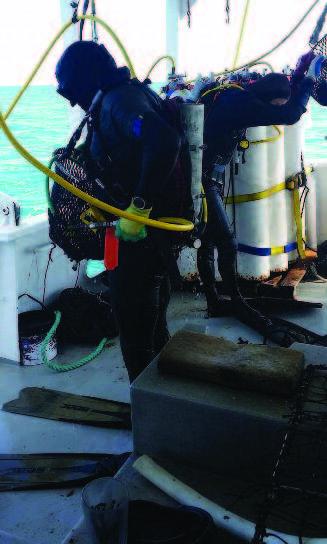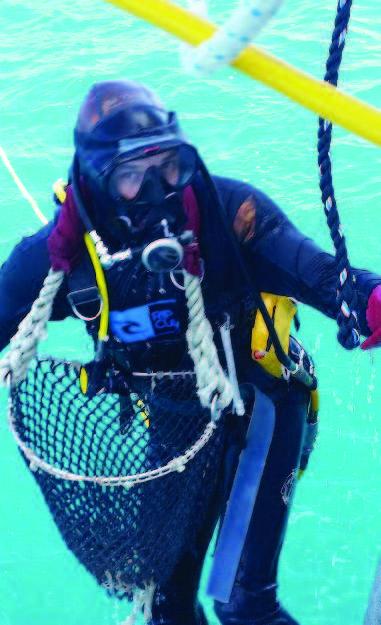2017 - EAT SLEEP DIVE REPEAT
Broome history tells us a lot about the times of the hard hat divers, and what it was like for them back in the early days of Broome’s pearling industry. But what are the experiences of a modern-day pearl diver? Adam Morrow, who has been working as a pearl drift diver for the last 5 years, tells us what it’s like.
Pearl drift diving is completely different to what 99% of the population call a job. There are only about 50 pearl drift divers in Australia so you could say it is kind of specialised!
In a nutshell, the main job of a drift diver is to collect wild growing Pinctada Maxima – or mother of pearl shell. The shell we catch will then be used to be seeded with the beginnings of a pearl, moved to a farm and continue the next 2 years of its life growing a pearl.
A drift ‘season’ runs for 6 to 8 months of the year, from around March to September or October. The season finishes when the quota for that year has been caught. All drifting is done on neap tides, and we live on the boat during this time. Spring tides are our days off, you can’t drift on springs as the visibility is bad and the water movement is stronger.
The boat I work on runs with 6 divers, with all divers in the water. We have one deckie, a cook and a skipper. Other boats run with more divers. Mostly we fish along the 80 Mile beach, just south of Broome. The majority of the area here we dive is around 15 metres depth.
Each morning is before sunrise, we pull the anchor and everyone gets up. After breakfast, we get into our wetsuits and gear up in preparation for getting into the water. As soon as the sun peaks over the horizon, you have about 5 minutes until you are in the water, that’s when you switch on for the day and get your head in the game. Depending on what depth of water we are diving in, we usually do 8 to 9 dives a day. Each dive is around 40 minutes bottom time, a decompression stop and then 20 minutes on the surface between each dive. It’s not unusual to come up from your last oxygen decompression stop and the sun will have already set. We drift along behind the boat, holding onto a rope. We drift at the speed of a quick walking pace. We always drift with the tide.
On a typical day, you could catch around 200 shells, so on average around 25 shells a dive. Once we pick them up, we put them in our neck bag, which is a rope bag designed to wear around your neck. Once your neck bag is full, you move yourself up your rope to a big bag, which you then tip all of your shell into. At the end of each dive, these big bags get winched up onto the boat by the deckie. The deckie then cleans the shell – they use a meat cleaver to chip off any growth, weed and sponge that is growing on the outside of the shell. Once the divers come up from our decompression stop, we jump in and help the deckie out doing this.
Once they are chipped on the table, the shells are then put into panels. They then get loaded onto a dinghy and then laid back down on the bottom of the fishing grounds until the technicians come and insert them with a nucleus which then grows the pearl. They are then sent to the farm to hang off long lines for 2 years and grow pearls.
We dive with a hookah system, which is run off a compressor with 6 air hoses coming from it. Then we all have a small air tank that we carry, a bail out bottle for emergency in case the hookah fails. All of the divers have a signal hose, which is attached back to the boat through a wire. We press this and it sets off a horn. So, we can all communicate with the boat, and we have a series of signals that we use, similar to Morse code. We can send up signals to the skipper and deckie; speed up, slow down, emergency etc.
The bottom is what we call a garden bottom, it isn’t a heavy reef bottom. It’s mainly sand, lots of sponges, sea whips, coral cups and weed. The pearl shells are always hidden. People seem to think that they are in the open, but they are only quite small, the size of the palm of your hand and they’ll be growing underneath things, behind things, attached to growth or occasionally in the open. Sometimes you don’t see them unless you look backwards and side to side. You spend your day swimming around with your head about a metre from the bottom, looking, searching and swimming for these shells!
As the day goes on, our oxygen decompression stops increase. The last decompression stop of the day might be up to 30 minutes. You get nitrogen build up in your blood when you dive, which essentially is what gives you the bends. Breathing pure oxygen underwater is the quickest way to get rid of this nitrogen out of your body. This allows us to do more dives in the day. If we didn’t do the oxygen decompression stops, we could only do 2-3 dives a day.
I get asked all the time about sharks. They’re not something you typically need to be concerned about. Each year you might see one or two sharks of the nasty, bitey variety. They are usually very docile and inquisitive creatures…they will swim up to have a look at you, then swim away just as quickly. They just do their own thing. The thing we see the most of besides fish is sea snakes. They are very inquisitive as well. They follow you, especially around breeding season when they come and wrap around your dive hose to find out what it is!
I’ve seen guys get stung by Irukandji jellyfish, which are around early in the season when the water is still warm. I have seen guys go through a sting; it looks like a very painful experience. The boats do carry morphine for particularly severe cases. I’ve never been stung, touch wood.
People find it hard to believe it gets cold. The water can range from anywhere between 32 degrees to 18 degrees. When you are spending 8 to 9 hours a day underwater in 18-degree water, it does get extremely cold. This is hard to believe in the tropics! We can go from diving in a lycra suit to a 10mm wetsuit. Some guys wear less but I don’t like the cold, so I wear a thicker suit.
We eat around 6 meals a day – diving is hungry work. Our cook works hard. We love our cooked breakfasts and lunches. When its windy and cold, you might think why I am doing this job but the food helps to get us through the dives.
Another thing people always ask is if I find any pearls – but we would never know. The diver would never know because we don’t open the shells. But the technician would when they are seeding. There are natural pearls, they are rare, but they sometimes get lucky. A natural pearl can be worth a lot of money!
When you are working on the ocean, you are working with the weather and the elements and diving can be a mental battle some days. On a good day, it is the best job you could ever have, and on a bad day…say if it is windy and cold and you’re not catching many shell, you think what the hell am I doing to myself. It’s a very physical job, so the physical aspect combined with the mental aspect of being away from home, the weather etc. can sometimes be hard. Early in the season when your fitness may not be up to scratch, the physical struggle can create mental battles but later in the year when it cools down and the water temperature drops, the cold can be hard to deal with. When shell catch is low, you need to keep motivated and positive. People’s moods on the boat can affect everyone, you need to manage your moods. But you just deal with it, and everyone has their own way of dealing with these days. We have a saying, ‘Eat Sleep Dive Repeat’.
You go down there and sometimes you have to pinch yourself that you are working under water for that many hours of the day. All you have to do is one dive, see something cool and think this is a pretty awesome job. It’s the adrenaline, the catching shell, when you have a day when you catch a lot, and everyone is on a high. You are always hoping and striving for these days – it is an addictive job. But not a job you can do long term, 5 or 6 years is considered to be a long drift diving career. It’s a young person’s game, and a lifestyle job. It’s not for everyone but if you like it, it’s a lot of fun.
It's not all glitter and rainbows and it’s not for everyone, there’s a lot of hard work, there’s a lot of pain to get through some days. You have to love the water and enjoy being in it, it’s not a job you can make yourself like. You either love it or hate it, there is little in between. But the rewards, personally and financially are good and when it’s a beautiful day, you wouldn’t want to be anywhere else.


